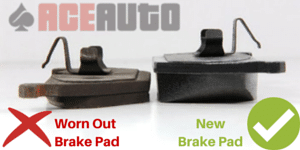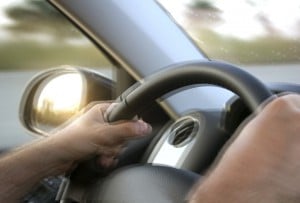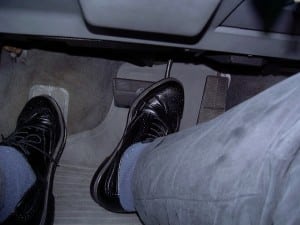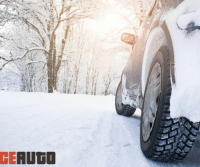Transmission Repair Specialists in West Jordan, Utah
Is your vehicle experiencing transmission troubles? We're transmission repair geniuses! We guarantee we can fix your transmission and get you up and running in no time.
READ MORE -

Here at Ace Auto Repair, we want you to know the 5 signs of worn brakes. We like our customers to feel safe and secure in their vehicle. By knowing what to look and listen for, you could save money by catching small problems with your brakes before they become an even bigger problem.
 Worn Brake Pads
Worn Brake PadsMost cars use what are known as disc brakes. A hydraulic system filled with brake fluid triggers a set of pads that clamp down on the cars calipers, which causes them to squeeze together on a disc known as the rotor. The friction that occurs between the pads and rotor eventually stops the car. Over time, as you can imagine, the pads will begin to wear thin, which means they'll become less effective at slowing and stopping your car. To check the thickness of your brake pads, all you need to do is look between the spokes of your wheel to spot the shiny metal rotor inside. When you find it, look around the outer edge where you'll see the metal caliper. Between the caliper and rotor, you'll see the pad. You'll have to estimate, but generally, your pads should be at least one-quarter of an inch thick. If they're any thinner than that, it's a good idea to get them changed. If your car wheel isn't designed in such a way that you can see through the spokes, you'll have to remove the tire to see the rotor and pads. In either case, while you're looking, it's also a good idea to inspect the rotor itself. It should be relatively smooth. If you see any deep grooves or pits, it might also be time to replace that, as well.
 One of the warning signs that your brakes need servicing can come from a small indicator in your braking system that emits a high-pitched squeal when your pads need replacing. In addition to the squeal from the sensor, you'll also want to listen for a harsh grinding sound. This means that you've gone completely through your brake pads and now, when you apply the brakes, the metal of the calipers is grinding against the metal of your rotors. Not only is this an ineffective way to stop your car, chances are good that you'll also damage your rotors, thus turning a relatively easy and inexpensive pad job, into a more costly rotor resurfacing or replacement ordeal. Remember each brake pad comes equipped with a wear indicator that squeals when your pads need replacing.
One of the warning signs that your brakes need servicing can come from a small indicator in your braking system that emits a high-pitched squeal when your pads need replacing. In addition to the squeal from the sensor, you'll also want to listen for a harsh grinding sound. This means that you've gone completely through your brake pads and now, when you apply the brakes, the metal of the calipers is grinding against the metal of your rotors. Not only is this an ineffective way to stop your car, chances are good that you'll also damage your rotors, thus turning a relatively easy and inexpensive pad job, into a more costly rotor resurfacing or replacement ordeal. Remember each brake pad comes equipped with a wear indicator that squeals when your pads need replacing.
 Has your car ever felt like your car has a mind of its own? As if it wants to make right or left hand turns while driving or braking? If so, this could indicate a problem with the braking system. The cause of this pulling might be a stuck caliper. Because such a scenario would cause friction on one wheel and not the others, your car can pull to the side where the caliper is stuck. Two other brake-related scenarios that could cause a car to pull would be a collapsed brake hose that would cause your calipers to move unevenly when applying the brakes, or uneven brake pads, which would also apply different amounts of pressure to different wheels. Pulling, however, doesn't always indicate a problem with the brakes. The cause could also come from unevenly inflated or worn tires, poor alignment or a problem with your vehicle's suspension. This is why, if your car begins to pull, you may want to pull up to the Ace Auto Repair and have our ASE technician do a full checkup on the problem.
Has your car ever felt like your car has a mind of its own? As if it wants to make right or left hand turns while driving or braking? If so, this could indicate a problem with the braking system. The cause of this pulling might be a stuck caliper. Because such a scenario would cause friction on one wheel and not the others, your car can pull to the side where the caliper is stuck. Two other brake-related scenarios that could cause a car to pull would be a collapsed brake hose that would cause your calipers to move unevenly when applying the brakes, or uneven brake pads, which would also apply different amounts of pressure to different wheels. Pulling, however, doesn't always indicate a problem with the brakes. The cause could also come from unevenly inflated or worn tires, poor alignment or a problem with your vehicle's suspension. This is why, if your car begins to pull, you may want to pull up to the Ace Auto Repair and have our ASE technician do a full checkup on the problem.
 If your brake pedal pulses under normal braking circumstances, you could have a problem. Generally, a vibrating brake pedal indicates warped rotors. Their uneven surfaces will thrum against the brake pads, and you'll feel the feedback through the brake pedal. Rotors usually only warp when they're under extreme stress for an extended period. The friction-generated heat caused by driving down steep mountainsides or by stopping frequently while towing something heavy, can cause the metal of the rotors to change shape. If you haven't stressed your brakes recently, but you still feel vibration in the pedal, it may be best to take it in for a diagnostic test.
If your brake pedal pulses under normal braking circumstances, you could have a problem. Generally, a vibrating brake pedal indicates warped rotors. Their uneven surfaces will thrum against the brake pads, and you'll feel the feedback through the brake pedal. Rotors usually only warp when they're under extreme stress for an extended period. The friction-generated heat caused by driving down steep mountainsides or by stopping frequently while towing something heavy, can cause the metal of the rotors to change shape. If you haven't stressed your brakes recently, but you still feel vibration in the pedal, it may be best to take it in for a diagnostic test.
 In addition to thrumming, your brake pedal can give you other indications that your car's braking system might need examining. A mushy pedal, one that goes practically to the floor before engaging the brakes, could indicate worn pads or a problem with the hydraulic system, such as air in the line, an air leak, or a brake fluid leak. To check for a fluid leak, put an old white sheet or piece of light cardboard under the car overnight. In the morning, examine any fluid that collects. Brake fluid will be practically clear and the consistency of cooking oil. The opposite of a mushy pedal is one that causes the brakes to grab immediately at the slightest touch. This could indicate an unevenly worn rotor, dirty brake fluid, or contamination of the fluid by moisture. You can solve such a problem with a relatively inexpensive change of fluid.
In addition to thrumming, your brake pedal can give you other indications that your car's braking system might need examining. A mushy pedal, one that goes practically to the floor before engaging the brakes, could indicate worn pads or a problem with the hydraulic system, such as air in the line, an air leak, or a brake fluid leak. To check for a fluid leak, put an old white sheet or piece of light cardboard under the car overnight. In the morning, examine any fluid that collects. Brake fluid will be practically clear and the consistency of cooking oil. The opposite of a mushy pedal is one that causes the brakes to grab immediately at the slightest touch. This could indicate an unevenly worn rotor, dirty brake fluid, or contamination of the fluid by moisture. You can solve such a problem with a relatively inexpensive change of fluid.
If you are experiencing issues with your car or trucks brakes, visit to Ace Auto Repair Utah for a diagnostic check. We guarantee all of our work and promise to get your vehicle up and running in no time. Call 801-803-6016 or visit us online at AceAutoUtah.com.


The cold weather is harsh on your car. In order to avoid expensive repairs – and dangerous accidents – check out what the sub-zero temperature can do to your car, and what you can do to help prevent problems.
A couple different things can go wrong with tires when cold weather strikes. First, tire pressure will vary according to temperature. A drop in temperature can cause your tires to quickly deflate – this is noticeable even when driving at night compared to driving during the day. Check your recommended tire pressure when the weather starts to get chilly. Also keep in mind that many tires are still made with rubber materials, and these materials will harden when the weather gets cold. This can cause tread and gripping problems in all-season tires. Winter tread tries are designed to resist this problem with alternative materials – another good reason to consider switching to winter tires.
When the weather gets seriously cold, your battery may struggle to operate correctly. This is caused by low temperatures interfering with the way that a battery operates and in some cases actually leeching away voltage, reduce the charge that a battery has to get a car started. The last thing you want in the middle of winter is to go out and find your car has a dead battery. There are several ways to avoid this problem. In the coldest areas, consider using available car heats. Make sure your battery is not too old – most batteries are in their peak condition for around 3 years. When the temperature starts dropping below zero, try to keep your car in a garage as often as possible.
While most of the fluids in your car have additives to keep them from freezing, this doesn't mean they aren’t affected by freezing temperatures. When the weather gets cold fluids grow sluggish, thickening and moving more slowly. This is most dangerous when it comes to transmission fluid, which needs to move effectively to manage car performance. However, sluggish brake fluid can also be disastrous. Even oil can thicken and struggle to perform. Check your fluids and replace or top off as needed.
Click here to read 5 Cold Weather Car Myths
Your engine really doesn't like cold weather. It will struggle to run efficiently when the temperature drops below zero, using a lot of gasoline very quickly to keep itself from stalling. Not only does this lower efficiency, but it also causes the build-up of water vapor. This is especially noticeable if you only run your engine for half an hour or so at a time. Try leaving your car running to stabilize your engine and get rid of accumulated water vapor. Heaters will also sap heat away from your engine, so avoid immediately turning on your heater when starting your car.
For the same reason that batteries tend to struggle in cold weather, spark plugs may also be in danger. Electricity simply does not fare well in cold, dry condition, and older spark plugs will only make conditions worse. So, before the coldest weather starts, check out your spark plugs for any sign of corrosion or age and replace them if necessary.
Windshields are very durable in modern cars, but some windshields may still be in danger of cracking, especially when mistreated in cold weather. Use the right kind of coolant, never wash with hot water in cold weather, and take special care of your wipe blade so that they don't freeze to your windshield. This can be aggravated if other cars are kicking up a lot of slurry into your windshield, especially slurry made with rock salt or similar components.
Older or more delicate engines may also be in danger of cracking if the engine block is vulnerable to sub-zero temperatures and your coolant is contaminated or inferior. Keep that coolant topped off and use the recommended formula!



Ace Auto Repair knows how the cold affects vehicles, and are conveniently located in West Jordan, Utah, and serves the surrounding areas. If you are need of engine repair or need a diagnosis, contact Ace Auto Repair today! We work on all makes and models of cars, trucks and SUV's. We are family owned company, and pride ourselves on being honest auto repair professionals.
Recent Comments